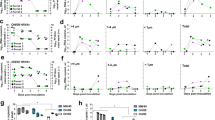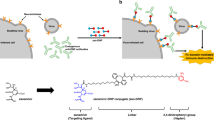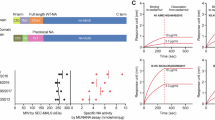Abstract
Recent gain-of-function studies in influenza A virus H5N1 strains revealed that as few as three-amino-acid changes in the hemagglutinin protein confer the capacity for viral transmission between ferrets1,2. As transmission between ferrets is considered a surrogate indicator of transmissibility between humans, these studies raised concerns about the risks of gain-of-function influenza A virus research. Here we present an approach to strengthen the biosafety of gain-of-function influenza experiments. We exploit species-specific endogenous small RNAs to restrict influenza A virus tropism. In particular, we found that the microRNA miR-192 was expressed in primary human respiratory tract epithelial cells as well as in mouse lungs but absent from the ferret respiratory tract. Incorporation of miR-192 target sites into influenza A virus did not prevent influenza replication and transmissibility in ferrets, but did attenuate influenza pathogenicity in mice. This molecular biocontainment approach should be applicable beyond influenza A virus to minimize the risk of experiments involving other pathogenic viruses.
This is a preview of subscription content, access via your institution
Access options
Subscribe to this journal
Receive 12 print issues and online access
$259.00 per year
only $21.58 per issue
Buy this article
- Purchase on SpringerLink
- Instant access to full article PDF
Prices may be subject to local taxes which are calculated during checkout




Similar content being viewed by others
References
Herfst, S. et al. Airborne transmission of influenza A/H5N1 virus between ferrets. Science 336, 1534–1541 (2012).
Russell, C.A. et al. The potential for respiratory droplet-transmissible A/H5N1 influenza virus to evolve in a mammalian host. Science 336, 1541–1547 (2012).
Palese, P. & Shaw, M.L. Orthomyxoviridae: the viruses and their replication. in Fields Virology (eds. Knipe, D.M. et al.) 1647–1690 (Lippincott Willams & Wilkins, 2007).
Tumpey, T.M. et al. Characterization of the reconstructed 1918 Spanish influenza pandemic virus. Science 310, 77–80 (2005).
Gao, R. et al. Human infection with a novel avian-origin influenza A (H7N9) virus. N. Engl. J. Med. 368, 1888–1897 (2013).
Liu, J. et al. Highly pathogenic H5N1 influenza virus infection in migratory birds. Science 309, 1206 (2005).
Maines, T.R. et al. Lack of transmission of H5N1 avian-human reassortant influenza viruses in a ferret model. Proc. Natl. Acad. Sci. USA 103, 12121–12126 (2006).
Zhu, H. et al. Infectivity, transmission, and pathology of human H7N9 influenza in ferrets and pigs. Science 341, 183–186 (2013).
Xiong, X. et al. Receptor binding by a ferret-transmissible H5 avian influenza virus. Nature 497, 392–396 (2013).
Tharakaraman, K. et al. Structural determinants for naturally evolving H5N1 hemagglutinin to switch its receptor specificity. Cell 153, 1475–1485 (2013).
Zhang, Y. et al. H5N1 hybrid viruses bearing 2009/H1N1 virus genes transmit in guinea pigs by respiratory droplet. Science 340, 1459–1463 (2013).
Fouchier, R.A. et al. Pause on avian flu transmission research. Science 335, 400–401 (2012).
Langlois, R.A., Varble, A., Chua, M.A., Garcia-Sastre, A. & tenOever, B.R. Hematopoietic-specific targeting of influenza A virus reveals replication requirements for induction of antiviral immune responses. Proc. Natl. Acad. Sci. USA 109, 12117–12122 (2012).
Perez, J.T. et al. MicroRNA-mediated species-specific attenuation of influenza A virus. Nat. Biotechnol. 27, 572–576 (2009).
Chua, M.A., Schmid, S., Perez, J.T., Langlois, R.A. & Tenoever, B.R. Influenza A virus utilizes suboptimal splicing to coordinate the timing of infection. Cell Rep. 3, 23–29 (2013).
Marcet, B. et al. Control of vertebrate multiciliogenesis by miR-449 through direct repression of the Delta/Notch pathway. Nat. Cell Biol. 13, 693–699 (2011).
Schrauwen, E.J. et al. The multibasic cleavage site in H5N1 virus is critical for systemic spread along the olfactory and hematogenous routes in ferrets. J. Virol. 86, 3975–3984 (2012).
Suguitan, A.L. Jr. et al. The multibasic cleavage site of the hemagglutinin of highly pathogenic A/Vietnam/1203/2004 (H5N1) avian influenza virus acts as a virulence factor in a host-specific manner in mammals. J. Virol. 86, 2706–2714 (2012).
Medina, R.A. & Garcia-Sastre, A. Influenza A viruses: new research developments. Nat. Rev. Microbiol. 9, 590–603 (2011).
Steel, J. et al. Live attenuated influenza viruses containing NS1 truncations as vaccine candidates against H5N1 highly pathogenic avian influenza. J. Virol. 83, 1742–1753 (2009).
Wan, H. et al. Replication and transmission of H9N2 influenza viruses in ferrets: evaluation of pandemic potential. PLoS ONE 3, e2923 (2008).
Barnes, D., Kunitomi, M., Vignuzzi, M., Saksela, K. & Andino, R. Harnessing endogenous miRNAs to control virus tissue tropism as a strategy for developing attenuated virus vaccines. Cell Host Microbe 4, 239–248 (2008).
Heiss, B.L., Maximova, O.A., Thach, D.C., Speicher, J.M. & Pletnev, A.G. MicroRNA targeting of neurotropic flavivirus: effective control of virus escape and reversion to neurovirulent phenotype. J. Virol. 86, 5647–5659 (2012).
Pham, A.M., Langlois, R.A. & TenOever, B.R. Replication in cells of hematopoietic origin is necessary for dengue virus dissemination. PLoS Pathog. 8, e1002465 (2012).
Acknowledgements
This work was supported by the Center for Research on Influenza Pathogenesis, a National Institute of Allergy and Infectious Diseases–funded Center of Excellence in Influenza Research and Surveillance (HHSN266200700010C). B.R.T. is supported in part by the US Army Research Office under grant numbers W911NF-12-R-0012 and W911NF-08-1-0413 and the Burroughs Wellcome Fund. MDCK cells were kindly provided by P. Palese (Mount Sinai School of Medicine).
Author information
Authors and Affiliations
Contributions
R.A.L. and R.A.A. designed and conducted the research and wrote the manuscript. B.K., T.S., C.F., A.S.G.-R., M.A. and K.X. were responsible for the transmission experiments. J.S.S. performed and analyzed deep sequencing experiments. M.A.C. provided technical support. D.P., A.G.-S. and B.R.T. designed research, oversaw the project and wrote the manuscript.
Corresponding authors
Ethics declarations
Competing interests
The authors declare no competing financial interests.
Supplementary information
Supplementary Text and Figures
Supplementary Figures 1–4 (PDF 330 kb)
Supplementary Table 1
miRNA expression in A549, MDCK and ferret lung cells (XLSX 57 kb)
Rights and permissions
About this article
Cite this article
Langlois, R., Albrecht, R., Kimble, B. et al. MicroRNA-based strategy to mitigate the risk of gain-of-function influenza studies. Nat Biotechnol 31, 844–847 (2013). https://doi.org/10.1038/nbt.2666
Received:
Accepted:
Published:
Issue date:
DOI: https://doi.org/10.1038/nbt.2666
This article is cited by
-
A modified live bat influenza A virus-based vaccine prototype provides full protection against HPAIV H5N1
npj Vaccines (2020)
-
Gain-of-function experiments: time for a real debate
Nature Reviews Microbiology (2015)
-
Minimizing the risk
Nature Reviews Microbiology (2013)



